Tom's Hardware Verdict
The Ryzen 9 3900 offers incredible performance-per-watt within a friendlier 65W TDP envelope, which equates to less power consumption and lighter cooling requirements.
Pros
- +
Low power consumption
- +
Less thermal output
- +
PCIe 4.0 interface
- +
Overclocking support
Cons
- -
Only available in pre-built systems
Why you can trust Tom's Hardware
We recently took the then-unannounced Ryzen 9 3900 on a record-breaking overclocking spin with liquid nitrogen, but now we have the elusive chip here in our labs for standard performance testing.
AMD's 12-core 24-thread Ryzen 9 3900 takes the goodness of the impressive Ryzen 9 3900X and shrinks it down from a 105W TDP envelope to 65W. AMD accomplished this feat by trimming the base and boost frequencies, thus squeezing the lion's share of performance from AMD's current flagship Ryzen 9 3900X into desktop PCs with smaller form factors that focus on power efficiency.
With AMD's inaugural Ryzen lineup, the X-branded models served as the faster and more expensive models in the product stack, while less expensive "non-X" models featured the same physical design as the X-branded models but had lower performance at stock settings. That trade-off came with a hefty discount, and enthusiasts soon learned that overclocking unleashed nearly the same performance from non-X chips as the X models. That was a win in the value department, and non-X models quickly became the go-to chip for enthusiasts on a budget.
With the Ryzen 9 3900X, AMD dashed the hopes of enthusiasts and didn't release a non-X version. It turns out there is a non-X model, but it is headed to OEM and system integrator (SI) builds, meaning you'll have to buy the chip in pre-built systems.
However, the Ryzen 9 3900 also gives us a taste of what to expect from AMD's new Eco-Mode feature, which allows you to downshift AMD processors into lower TDP envelopes with a single click in the BIOS or Ryzen Master software.
Ryzen 9 3900 Specifications and Availability
| Header Cell - Column 0 | SEP (USD) | Cores / Threads | TDP | Base Frequency | Boost Frequency | Total Cache | PCIe 4.0 Lanes (Processor / Chipset) |
|---|---|---|---|---|---|---|---|
| AMD Ryzen 9 3900X | $499 | 12 / 24 | 105W | 3.8 GHz | 4.6 GHz | 70MB | 24 / 16 |
| AMD Ryzen 9 3900 | N/A | 12 / 24 | 65W | 3.1 GHz | 4.3 GHz | 70MB | 24 / 16 |
| AMD Ryzen 9 PRO 3900 | N/A | 12 / 24 | 65W | 3.1 GHz | 4.3 GHz | 70MB | 24 / 16 |
| Ryzen 7 3700X | $329 | 8 / 6 | 65W | 3.6 GHz | 4.4 GHz | 36MB | 24 / 16 |
| Ryzen 5 3600 | $199 | 6 / 12 | 65W | 3.6 GHz | 4.2 GHz | 35MB | 24 / 16 |
| Ryzen 5 3500X | N/A | 6 / 6 | 65W | 3.6 GHz | 4.1 GHz | 35MB | 24 / 16 |
AMD designed the Ryzen 9 3900 to offer most of the 12-core, 24-threaded horsepower of the impressive Ryzen 9 3900X, but within a much lower 65W TDP range than its 105W sibling.
The 3900's reduced power consumption manifests as a lower 3.1 GHz base clock than the 3900X's 3.8 GHz base frequency. AMD also pared back the boost clock from 4.6 GHz to 4.3 GHz.
Get Tom's Hardware's best news and in-depth reviews, straight to your inbox.
AMD tunes its "X" models to the very edge of the frequency/voltage curve to extract the utmost performance from TSMC's 7nm node, some of which we see with the chips' relatively lackluster overclockability. The Ryzen 3000 series processors aren't known for their overclocking headroom, but that's because AMD pushes the 7nm process near its limits for its retail silicon.
The company has even employed an innovative new binning technique paired with smart engineering to extract the last few percentage points of performance from each core. However, that tuning is designed to satisfy the enthusiast market's need for speed, and there is a diminishing point of power efficiency returns as AMD climbs the voltage/frequency curve. It's a simple concept: High-performance chips exchange higher power consumption, and thus thermal output, for higher performance. Dialing back the frequency reduces peak performance, but can offer much better power efficiency while retaining most of the performance.
Aside from those alterations, the Ryzen 9 3900 is physically identical to the 3900X, meaning it features the threaded grunt of the company's Zen 2 architecture and the fruits of the 7nm process, like lower power consumption and higher performance. It also has the same 64MB of L3 cache, access to 24 lanes of PCIe 4.0, supports overclocking, and comes with and all of the other high-level features of the Ryzen 9 3900X. AMD also recently announced the PRO variant of the 3900, which sports the same specifications but includes a few optimizations for the professional market.
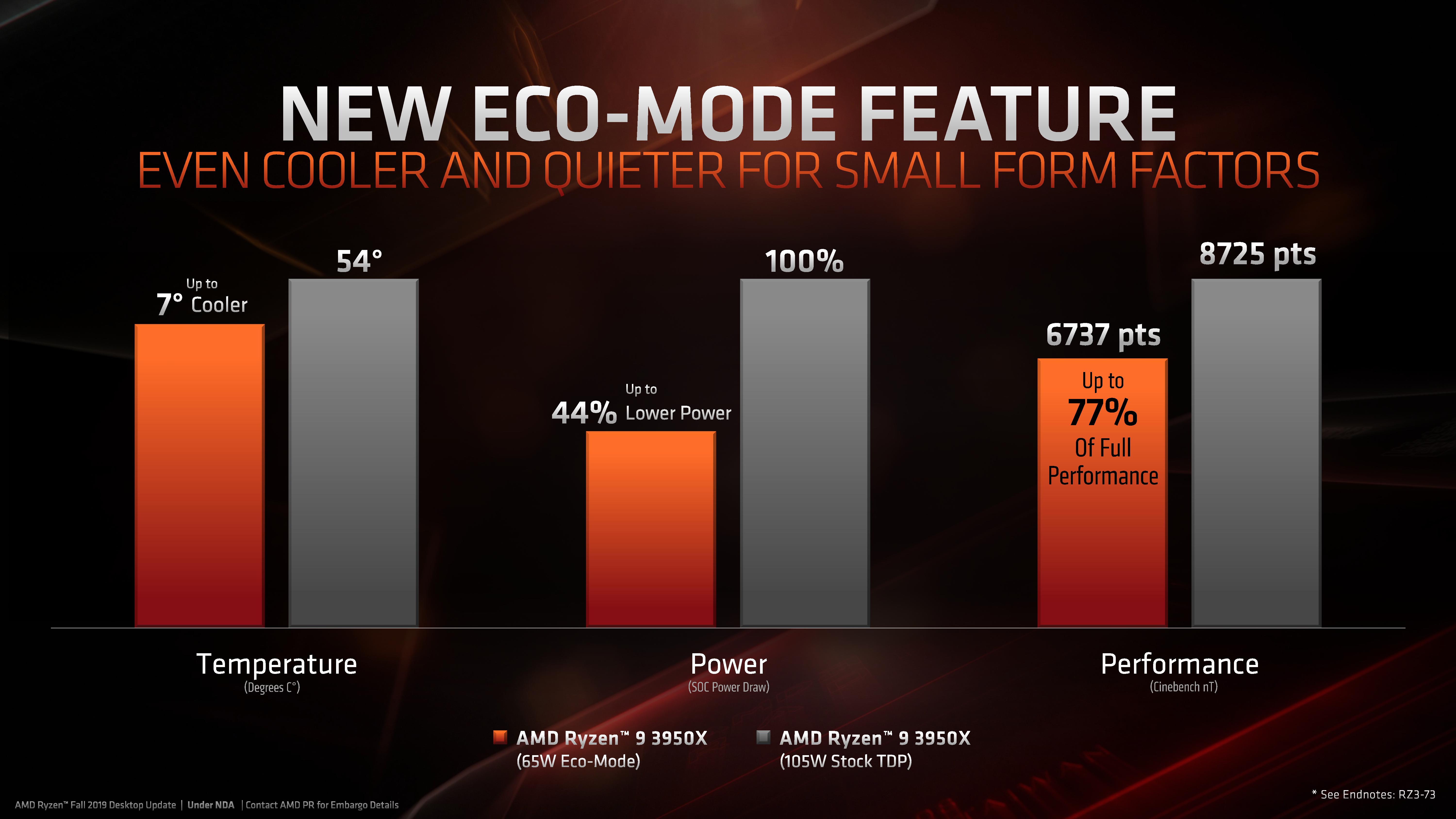
During its Ryzen 9 3950X launch, AMD revealed that it is also rolling out a new Eco-Mode feature that allows you to cram an incredible amount of horsepower into a small form factor build, like a Plexbox or DIY NAS. This feature downshifts the processor from its rated TDP to the next lower 'grade,' meaning you can drop a 105W processor to 65W, or a 65W processor to 45W. AMD will make this feature available for all Ryzen processors via a motherboard firmware update, after which you can make the adjustments in either the BIOS or Ryzen Master software. The easy-to-use feature should prove very handy for SFF enthusiasts, though making a few manual adjustments to the power thresholds would provide many of the same benefits.
AMD has only provided comparative data for Eco Mode on the 3950X, but these general trends should apply to all Ryzen models. AMD claims the 65W mode on the 3950X offers 77% of the chip's full performance in a multi-threaded CineBench workload, but at a 44% power savings that results in a 7C reduction in temperatures.
In effect, this feature gives you the option to create a Ryzen 9 3900 out of your 3900X, affording the same advantages of reduced power consumption and thermal output while retaining the majority of its performance. It also opens the door to pairing the chip with less expensive motherboards without robust power circuitry. You just don't get the cost savings of buying a non-X model.
Ryzen 9 3900 Boost Testing

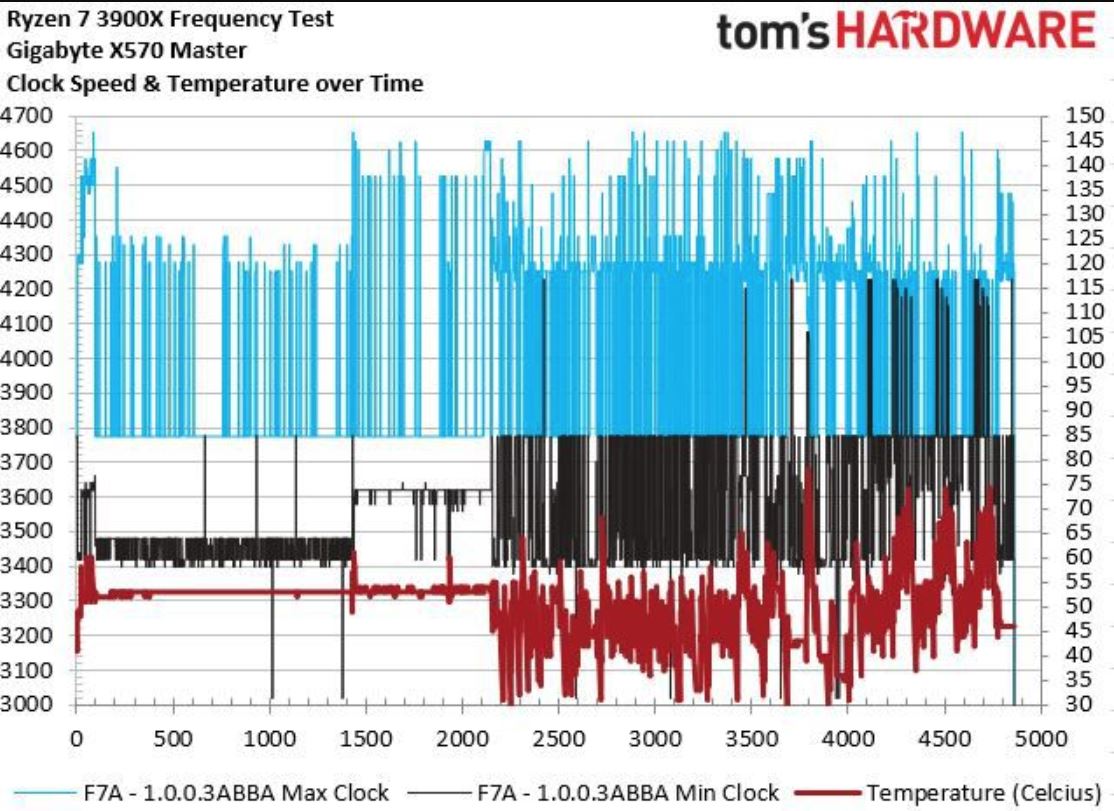
Ryzen 3000 debuted to some criticism due to the chips' inability to hit the rated boost clock speeds, but AMD said it identified the issue and issued AGESA code updates that motherboard vendors injected into their firmwares, largely rectifying the issue.
We recorded the frequencies of each core during a series of benchmarks (LAME, POV-RAY, Cinebench, PCMark 10, Geekbench, and VRMark) to expose the 3900's peak frequencies and thermal output. The per-core frequency recordings create almost unintelligible charts, so we only plotted the maximum and minimum frequencies recorded during each 1-second measurement interval. These measurements could come from any one core, but it makes the charts easier to digest. We've also plotted chip temperature on the right axis (the dark red line). We used the Corsair H115i AIO cooler for these tests.
The Ryzen 9 3900 officially has a 4.3 GHz boost clock, but we recorded frequent peaks of 4.35 GHz at stock settings. The chip operates between ~35C and ~65C, with most of its time spent around 45C. Meanwhile, the Ryzen 9 3900X hits 4.65 GHz frequently, but also has a temperature range that extends from ~35C to ~80C, highlighting the huge power and thermal savings of stepping down to a lower TDP range with the Ryzen 9 3900.
We designed that series of tests to measure performance in lightly- and multi-threaded tests, but comparisons with extended x265 HandBrake encoding are indicative of a heavier multi-core AVX load. The Ryzen 9 3900 peaked at 69C and spent the majority of its time during the benchmark at ~60C, while the Ryzen 9 3900X peaked at 87C and hovered around 80C. That isn't a bad trade-off for the 8.75% reduction in performance we measured during the benchmark.
Ryzen 9 3900 Power Consumption


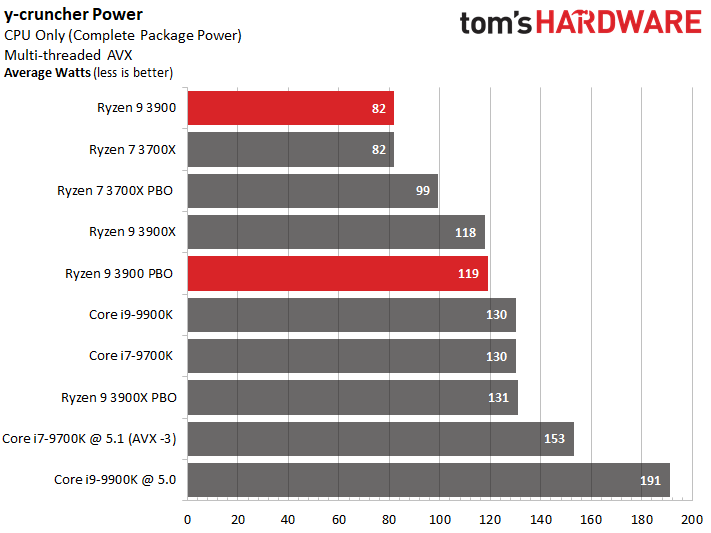

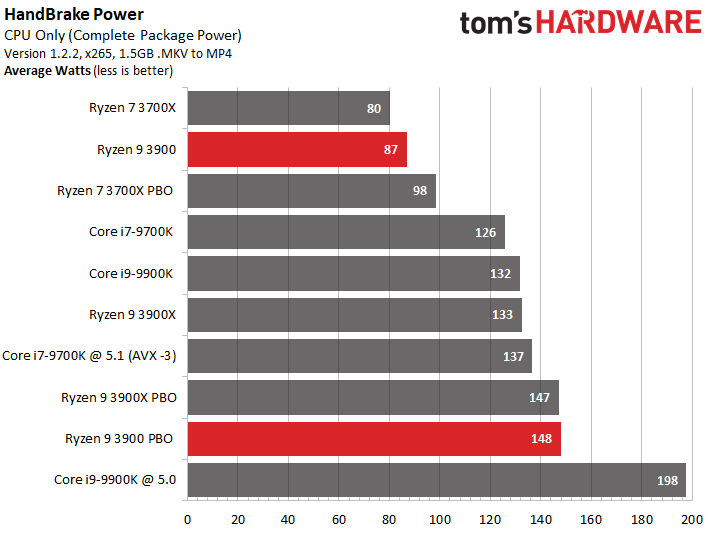
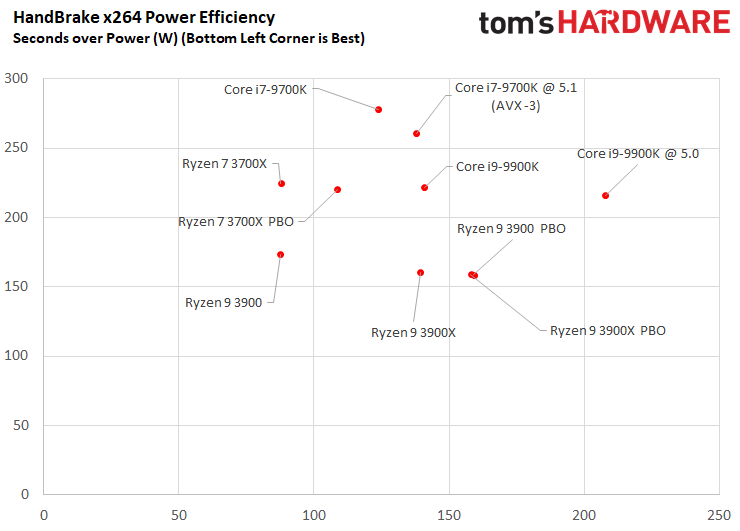


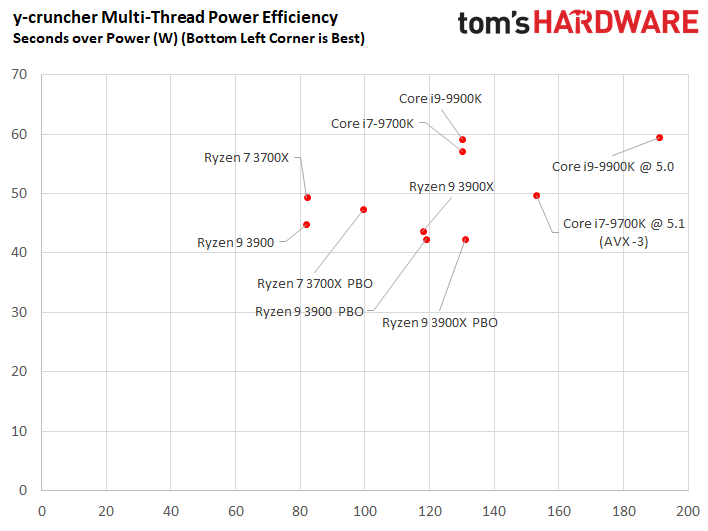
It's important to remember that TDP isn't a one-to-one measure of power consumption. In the simplest terms, this rating quantifies the required performance of the CPU cooler based upon the chips' thermal dissipation – not power consumption. That means we won't see the Ryzen 9 3900 operate at 65W of power consumption.
Here we can see the stock 3900 match the 65W 3700X's power consumption in nearly all of our stress and application tests. That's notable because we're looking at a power budget for an eight-core processor against a 12-core, but you'll notice in our scatter charts that the 3900 is significantly faster than the 3700X during the application benchmarks. It's also either as fast, or faster, than Intel's 95W Core i9-9900K in some workloads, but with lower power consumption. That equates to solid power efficiency metrics.
The chip did exhibit some odd behavior when we flipped into the auto-overclocked PBO mode. The overclocked 3900 consumes the same amount of power that it does at stock during our synthetic AVX and non-AVA AIDA64 stress tests, but we see the expected increase in overclocked power consumption when we switch over to actual workloads. That could be an oddity with AMD's power control algorithms, but it certainly is interesting.
Synthetic stress tests aside, after uncorking the power limits via overclocking, the 3900's increased power consumption during the application benchmarks largely equates to the consumption of the overclocked 3900X (except for the multi-threaded AVX y-cruncher workload). As expected, that results in the tuned 3900 delivering roughly the same performance as the 3900X in all of the tests. Oddly, it even offers the same performance in y-cruncher as the 3900X, but consumes 12W less. This could simply boil down to silicon quality.
Overall, these results bode well. The stock Ryzen 9 3900 gives you significantly more performance-per-watt than the eight-core 3700X in these tests, but you gain some thermal headroom compared to the standard Ryzen 9 3900X. That means the chip can slip into smaller form factor PCs with smaller coolers.
That's promising for switching a Ryzen 9 3900X into Eco Mode. Let's see what the results look like throughout the rest of our suite of benchmarks.
CONTENT
1: Cramming 12 Cores & 24 Threads into a 65W TDP
3: AMD Ryzen 9 3900 Application Testing
4: Conclusion
MORE: Best CPUs
MORE: Intel & AMD Processor Hierarchy
MORE: All CPUs Content
Current page: Cramming 12 Cores and 24 Threads into a 65W TDP
Next Page AMD Ryzen 9 3900 Gaming
Paul Alcorn is the Editor-in-Chief for Tom's Hardware US. He also writes news and reviews on CPUs, storage, and enterprise hardware.
-
gggplaya Why not publish the IDLE power consumption, both just chip and total system consumption?? That's what really matter for people building a Plexbox or DIY NAS box.Reply -
Gillerer I believe an AMD representative has stated that AMD truncates the advertized clock speeds - removing the (mostly irrelevant) +50 MHz; That's why a CPU whose actual boost frequency is 4.35 GHz has a "4.3 GHz" printed on the box and in marketing materials. I think the rationale was along the lines of "it's prettier" or "it's easier to take in", or something.Reply
Due to the variations in motherboards, the 10 MHz digit isn't significant anyways; just a 100.5 MHz base clock would add +21.5 MHz to CPU speed at a 43 multiplier. -
svan71 "friendlier 65W TDP " ? I'd like a meaner 140 w version at 5GHZ, you can keep the friendlier versions.Reply -
iam2thecrowe Reply
Agree, publishing idle power is relevant, but anyone building a plexbox/nasbox/HTPC is going to opt for a much lower end CPU.gggplaya said:Why not publish the IDLE power consumption, both just chip and total system consumption?? That's what really matter for people building a Plexbox or DIY NAS box. -
gggplaya Replyiam2thecrowe said:Agree, publishing idle power is relevant, but anyone building a plexbox/nasbox/HTPC is going to opt for a much lower end CPU.
Not for me, I want more cores for transcoding. It takes about 2000 passmarks for every CPU encoded stream, so the 3900x can do 15 simultaneous streams. The 3900 will presumably do around 12 streams give or take.
GPU encoding looks terrible in Plex at low bitrates, like 3-6mbps, with tons of macroblocking on fast scenes. CPU encoding looks nice and clean at those bitrates. It might downgrade to 720p at those bitrates, but at least it's a clean image.
Another thing people do is use these processors as servers for virtual machines, again with the computers running 24/7. Idle power consumption matters again in this case as places like california have expensive electricity.
Also, some people can only have 1 computer, and not have a dedicated plexbox or NAS server. So they use their computer for gaming, work, video editing etc.... But leave it turned on 24/7 to act as a plex or file server. My coworker does this.
It would be awesome when reviewing CPU's in the future to have idle power consumption and the passmark score. It's something reviewers have been neglecting lately on most websites, and hard information to find. -
Paul Alcorn Replygggplaya said:Not for me, I want more cores for transcoding. It takes about 2000 passmarks for every CPU encoded stream, so the 3900x can do 15 simultaneous streams. The 3900 will presumably do around 12 streams give or take.
GPU encoding looks terrible in Plex at low bitrates, like 3-6mbps, with tons of macroblocking on fast scenes. CPU encoding looks nice and clean at those bitrates. It might downgrade to 720p at those bitrates, but at least it's a clean image.
Another thing people do is use these processors as servers for virtual machines, again with the computers running 24/7. Idle power consumption matters again in this case as places like california have expensive electricity.
Also, some people can only have 1 computer, and not have a dedicated plexbox or NAS server. So they use their computer for gaming, work, video editing etc.... But leave it turned on 24/7 to act as a plex or file server. My coworker does this.
It would be awesome when reviewing CPU's in the future to have idle power consumption and the passmark score. It's something reviewers have been neglecting lately on most websites, and hard information to find.
You're right, I feel it is a glaring omission, but hard to measure correctly. We ARE adding it though in some fashion. I solicited some suggestions here:
1189735229285707776View: https://twitter.com/PaulyAlcorn/status/1189735229285707776
feel free to weigh in either here or there with ideas of what you would like to see. Sorry for the delay on adding idle power, things have been...busy. -
gggplaya ReplyPaulAlcorn said:You're right, I feel it is a glaring omission, but hard to measure correctly. We ARE adding it though in some fashion. I solicited some suggestions here:
1189735229285707776View: https://twitter.com/PaulyAlcorn/status/1189735229285707776
feel free to weigh in either here or there with ideas of what you would like to see. Sorry for the delay on adding idle power, things have been...busy.
Yea, that would be awesome.
Personally I would just load windows, install all drivers and updates including motherboard driver updates and bios's. Set it to power savings plan or balanced and not install any programs. Let the machine sit for 45minutes.
Then measure the average power over say 10 minutes to get the idle power draw. -
bloodroses ReplyPaulAlcorn said:You're right, I feel it is a glaring omission, but hard to measure correctly. We ARE adding it though in some fashion. I solicited some suggestions here:
1189735229285707776View: https://twitter.com/PaulyAlcorn/status/1189735229285707776
feel free to weigh in either here or there with ideas of what you would like to see. Sorry for the delay on adding idle power, things have been...busy.
Would using something like Linux (command line or a bare window manager) be an option for testing idle power consumption since as you said Windows is well, Windows? It'd at least give a ballpark figure relative to (I assume) what Windows would use as well and be more consistent. You'd have to of course mention in the test that Linux is being used instead of Windows.
Another option could be something like Hiren's BootCD. -
King_V Reply
Lol, I'll admit I didn't see that coming, and it made me laugh!svan71 said:"friendlier 65W TDP " ? I'd like a meaner 140 w version at 5GHZ, you can keep the friendlier versions.